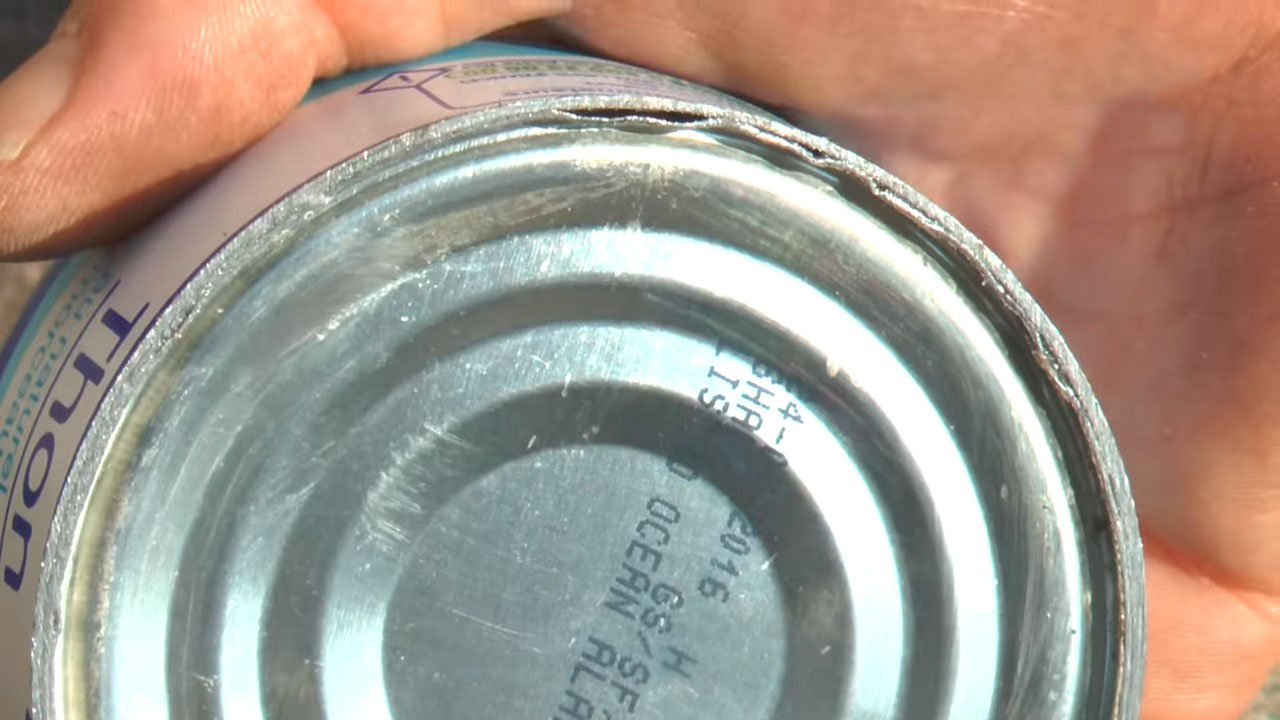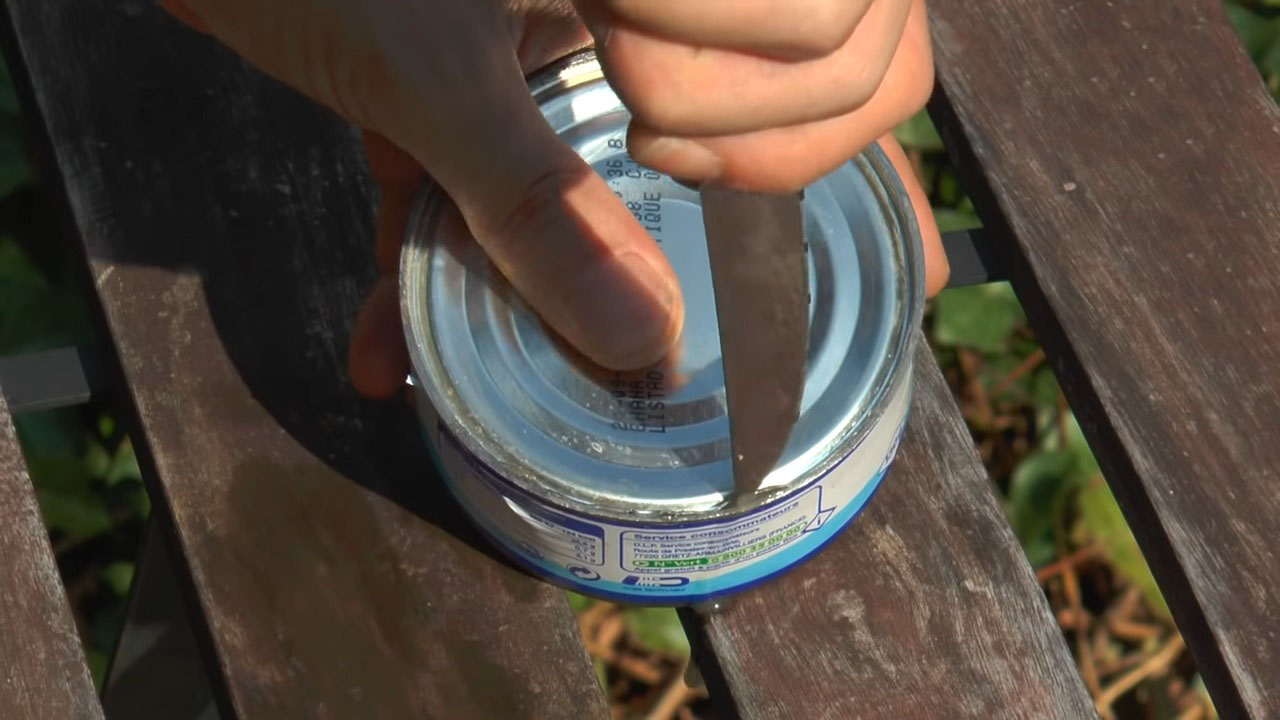When you’re out in the wild or facing an emergency at home, knowing how to open a can without a can opener can be a crucial skill. As a wilderness survival expert with over a decade of experience, I’ve encountered numerous situations where this knowledge has proven invaluable.
The creativity of using what’s available could mean the difference between a satisfying meal and an unopened can of food. Let’s explore effective methods for accessing canned goods when the traditional tool is out of reach.
The Spoon Technique
Most of us can locate a spoon in almost any setting, whether we’re rummaging through our kitchen drawers or our camping gear. The simple spoon can transform into an effective tool for penetrating a can’s lid with the right technique.
Step-by-Step Guide
- Positioning the Spoon: Firmly hold the spoon with your dominant hand. Place the tip of the spoon against the inner edge of the can’s lid, near the rim, where the seal seems weakest.
- Applying Pressure: Using a strong and steady grip, rub the spoon back and forth, creating friction and heat. This action will gradually weaken the can’s seal.
- Breaking Through: Continue the sawing motion until the metal thins out and you puncture through the lid. From there, carve outwards towards the edge to create a large enough opening.
Safety and Considerations
While the spoon method is effective, it requires caution. The edges of the can lid will be jagged once punctured, posing a risk of cuts. Always press away from your body and use gloves if available to protect your hands.
The Concrete Rubbing Method

When no tools are available, nature or your immediate surroundings can offer a solution. Concrete is a common and incredibly abrasive surface, which can be used to wear down the can’s lid.
- Step 1 – Finding a Suitable Surface: Locate a flat, rough concrete surface, such as a sidewalk or a concrete block.
- Step 2 – Rubbing the Can: Turn the can upside down and rub it vigorously against the concrete in a consistent circular motion.
- Step 3 – Opening the Lid: The friction will gradually remove the sealed edges of the lid. Once the metal is thin enough, squeeze the can gently to pop the seal, or use a flat object to pry the lid open.
Ensuring a Clean Process
During this process, ensure that the contents of the can don’t come into contact with the concrete. The goal is to remove only the top rim of the lid without allowing debris to mix with the food.
The Knife Method
A knife is a common tool carried by many outdoor enthusiasts and can serve as a precise instrument for opening a can in the absence of a can opener. Of course, you should make sure that your knife is sharp enough so it can open the can.
Detailed Instructions
- Place the can on a stable surface. Hold the knife in a sturdy grip, positioning the blade at a perpendicular angle to the can’s lid.
- Gently tap the knife’s handle with a rock or a heavy object to drive the blade into the lid. Once the blade is inserted, twist it to pry the lid open.
- Carefully move the knife around the lid’s perimeter, puncturing it along the way, to remove the top of the can.
Handling With Extreme Care
This method is perhaps the most hazardous due to the potential for the knife to slip. Keep a first aid kit handy and never force the knife. Patience is key to avoiding injury.

The Scissor Technique
Believe it or not, a pair of scissors can also open a can if you find yourself in a pinch. This method requires a sturdy pair of scissors, preferably with strong, sharp blades.
Systematic Approach
- Open the scissors wide and use one of the blades to puncture the can’s lid near the rim.
- Once you’ve made a puncture, use the scissors to cut around the rim. It’s similar to using a can opener, although it requires more strength and precision.
- Proceed slowly, making sure to keep the scissor blades lodged firmly in the lid as you cut.
Mind the Edges
Scissors can create sharp edges just like any other method, so caution is key. Ensure you hold the can steady and protect your hands and fingers from possible slippage.
The Hammer and Nail Method
A hammer and nail can serve as a primitive yet effective can-opening apparatus. This method is particularly useful when you need to access the can’s contents without needing to remove the entire lid.
- Puncturing the Lid: Place the nail against the can’s lid and gently tap it with the hammer until it pierces the metal. Repeat this step to create multiple holes around the perimeter of the lid.
- Relieving Pressure: Once enough holes are made, the pressure inside the can will decrease, making it easier to pry the lid open.
- Opening the Can: You can now insert a sturdy tool like a screwdriver or the claw end of the hammer into one of the holes to pry the lid open
FAQs
Can I open a can with a spoon if it’s not made of sturdy metal, like a plastic or wooden one?
A plastic or wooden spoon would not be effective for opening a can. These materials are too soft to penetrate the metal lid. You need a spoon made of strong, durable metal that can withstand the pressure required to puncture and carve through the lid of a can.
Is there a risk of contaminating food when using tools like nails or screws to open a can?
Yes, there’s a risk of contamination if the tools used are rusty or dirty. It’s important to ensure that any tool that comes into contact with the can’s contents is clean and rust-free.
Wipe the tool with a disinfectant if possible before using it to open a can to minimize the risk of food contamination.
How can I prevent sharp edges when using these methods to open a can?
Preventing sharp edges can be challenging, but using methods that cut or fold the lid inward rather than outward can help. For example, when using a knife or scissors, aim to push the cut edge of the lid into the can.
Always exercise caution and wear protective gloves if possible to guard against injury from sharp edges.
Is it possible to reseal the can after using one of these opening methods if I don’t use all the contents?
Most of the alternative can-opening methods will bend or cut the lid in such a way that resealing the can isn’t feasible. If you need to save the remaining contents, it’s best to transfer them to another container with a resealable lid for storage.
Can these methods be used on all types of cans, including those with pop-top lids?
These methods are generally intended for traditional cans without pop-top lids. Pop-top lids are already designed for easy opening without tools. However, if the pop-top mechanism fails, you could use the screwdriver or multi-tool methods to pry open the lid carefully.
How can I ensure that food doesn’t get spilled or splattered while opening a can with these methods?
To avoid spilling or splattering the contents, start by opening the can slowly and carefully. Avoid using excessive force, which can cause the contents to spray.
Also, try to open the can while it’s on a stable, flat surface, and consider leaving a small section of the lid attached, so you can lift it and pour the contents out in a controlled manner.
Summary
The ability to open a can without a can opener is a skill that can significantly enhance your self-reliance in various scenarios. Whether you choose to use a spoon, a concrete surface, or a knife, each method requires practice to perform safely and efficiently.
In the realm of wilderness survival and emergency preparedness, such skills are not just about convenience; they’re about sustenance and survival. Remember, the best tool you have is your knowledge and your willingness to adapt.
My name is Casey Harper, and I specialize in wilderness survival, navigation, and first aid. With over 12 years of experience as a wilderness survival instructor, I have had the privilege of guiding individuals and groups through challenging outdoor environments, ensuring their safety and teaching them essential survival skills. Additionally, I contribute to GearDisciple by writing insightful articles on survival strategies and reviewing outdoor gear. Through sharing my knowledge and experience, I aim to equip others with the skills and tools necessary for thriving in the wild, embracing the beauty and challenges it presents.